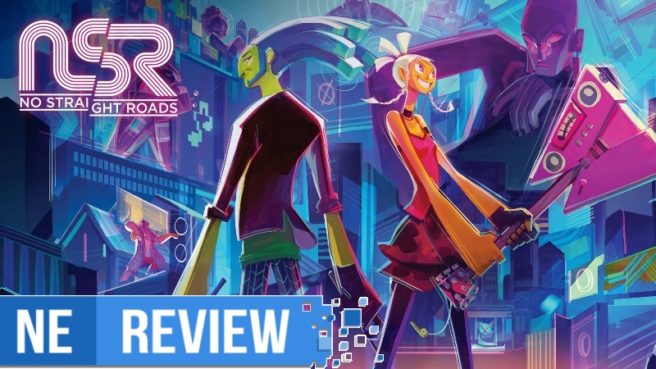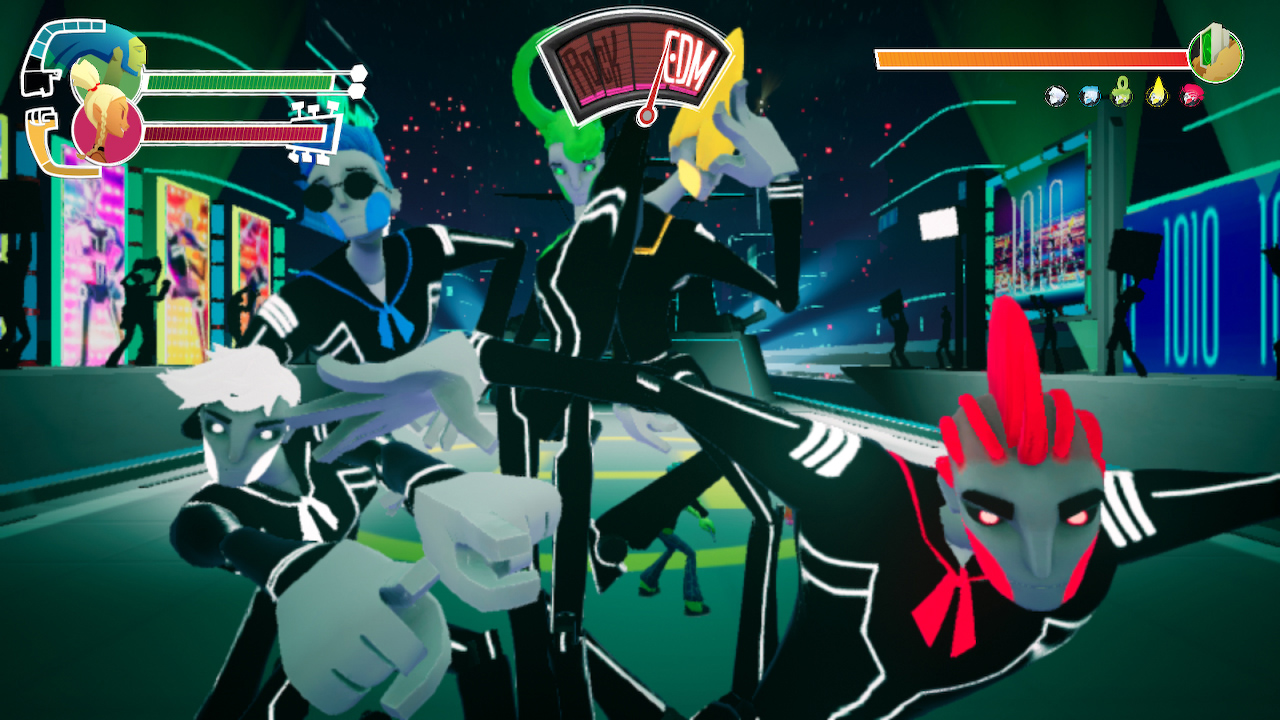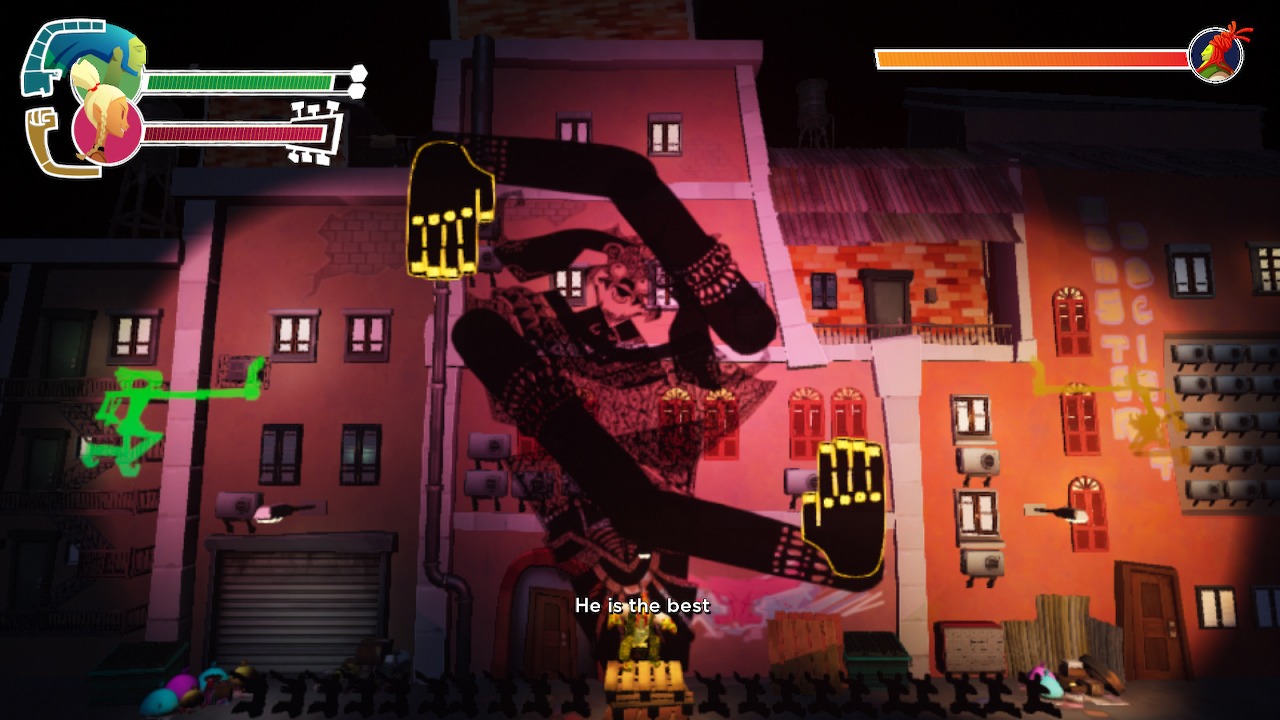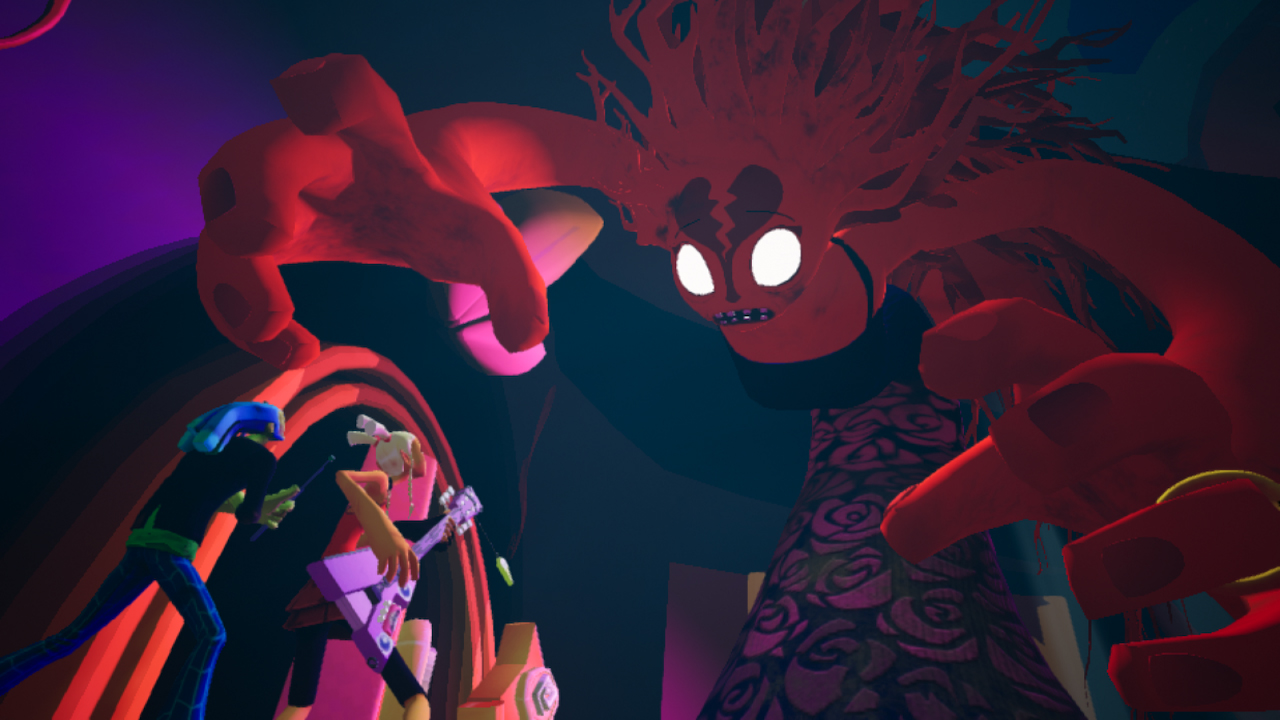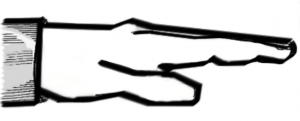[Review] No Straight Roads
System: Switch
Release date: August 25, 2020
Developer: Metronomik
Publisher: Sold Out
No Straight Roads is a prime example of a game that is more than the sum of its parts. Its gameplay may be decent at best for the most part, but its constant explosion of beautiful art, vibrant colors, and glorious music make it an overall unforgettable experience that needs to be played firsthand to be fully appreciated. This makes it all the more unfortunate that its aesthetics are heavily compromised in its Switch version, sullying its single greatest selling point.
No Straight Roads is set in a world literally powered by music. Electricity in Vinyl city is provided by the city’s many musicians, which means that those who control the music, control the government. The city has fallen under the control of a monopolistic record label called NSR, which exerts dictatorial control over the area to the point that it bans rock music in favor of EDM. This leaves it up to a rock band duo—a guitarist named Mayday and a drummer called Zuke – to rise up to take down NSR and liberate the city’s right to rock.
Perhaps surprisingly, this is a very narrative-focused game that features many lengthy, fully voice-acted cutscenes. Its music-obsessed setting is distinct, as many districts of Vinyl City have their own subcultures, advertisements, and fashion styles. No Straight Roads tells a story of social uprising that centers around its large and diverse cast of characters, not least of whom are Mayday and Zuke themselves. These heroes have an infectiously upbeat and optimistic attitude, and they’re brought to life with similarly endearing vocal performances. The large lineup of villains is also notable, from digital idol Sayu to the malicious CEO of NSR herself, Tatiana.
However, for such a narrative-focused game, the story doesn’t really go anywhere. It constantly introduces plot threads only to abandon them shortly thereafter. Characters constantly show up, introduce a mystery or conflict, and then vanish to never return. And then, the few characters that do have a constant presence in the plot typically have weak motivations and little development. The story is no deal-breaker in an action game like this, but it’s disappointing that it squandered its strong setup and memorable characters on a lackluster plot. So many plot holes leave the story feeling incomplete, to the point where the ending doesn’t seem to actually conclude much at all.
No Straight Roads’ gameplay is typical action fare on the surface. You can jump, roll, use light attack combos, and experiment with special attacks, and you can also switch between Zuke and Mayday on the fly. But it features one simple twist – it’s a music-themed game where you don’t have to move to the rhythm. Instead, it lets you act freely, while enemies move exclusively to the beat of the music. This gives you the option to either treat combat like you would in any other action title, or you could take the time to recognize enemy patterns and beat them with the power of song.
The gameplay loop is simple: you’ll explore an open hub world, find an NSR artist’s “district” of the city, hijack a concert, and take the opposing musicians down in a musical brawl. Before each showdown, you’ll have to break through the concert’s defenses in “approach” levels, which focus on light combat and platforming challenges. These sections are fun enough, but the real highlights of the entire game are the subsequent boss battles.
These battles are incredible spectacles from gameplay, visual, and auditory perspectives. Each one is completely unique from the rest, with its own artistic style, musical theme, and gameplay gimmicks. The battle against the brainy DJ Subatomic Supernova takes place on a model of the universe that he spins like a vinyl disc on a record player, while the piano prodigy Yinu’s boss battle will task you with avoiding giant musical notation flying from his keyboard in a classical concert hall. Such variety is complemented by incredible theme songs for each fight, making these encounters a treat for the senses from start to finish.
Even if the bosses can be gloriously spectacular, the moment-to-moment gameplay doesn’t hit the same high points. Controls can feel imprecise. Movement is floaty, and with the lack of a true lock-on feature, it can be difficult to land a full combo on an enemy without accidentally sliding past them. This is especially frustrating considering that the camera cannot be moved during battles. This is presumably meant to make it easier for two-player co-op, but it can result in a compromised gameplay experience. The camera can sometimes zoom out or stick at awkward angles, making it sometimes difficult to play. Individually, these issues aren’t deal-breaking, but they serve to bring the overall experience down, keeping it from fully excelling from a pure gameplay point of view.
By this point, you’ve probably gathered that where No Straight Roads truly excels is its presentation. Visually, it boasts of one of the most distinct and vibrant art directions I’ve seen in any game in recent years. Every character and environment bursts with color and personality – characters come in all shapes, sizes, and designs, yet they somehow manage to be cohesive thanks to a strong conceptual unity. Even the environments have been extremely fleshed out with incredible detail. Walking through Vinyl City reveals that nearly every crevice has been brought to life through intricate art and passionate creativity. From animated advertisements that play on billboards to abstract art nouveau in the art district, it’s clear that every detail has had an incredible amount of care poured into it.
That’s not to mention the music. A game with such a heavy focus on music had better have a memorable soundtrack, and No Straight Roads certainly doesn’t disappoint in this regard. Its OST is grand and luscious, filled with tracks in diverse genres from rock to hip-hop to classical to EDM. Each song perfectly complements its context, featuring lush instrumentation along with catchy melodies and rich harmonies. It’s easily a contender for one of the year’s best soundtracks – albums as varied and consistently engaging as this don’t come along every day. Combined with the strong visual direction, No Straight Roads is an incredible aesthetic experience that deserves to be played.
That’s why No Straight Roads’ Switch version is such a tragedy. Its visuals are essentially ruined in this muddy, jagged port – a crushing blow for a game that relies so much on its aesthetics. Performance can sometimes chug to a halt, and textures are extremely blurry if they even load at all. Character models are often extremely rough, sometimes to the point where they simply appear like a mess of pixels on the screen. It’s a mess to behold when blown up on the TV, with all its visual iniquities blown up for full view. Portable mode can somewhat make up for this, as the small screen can hide many of the visual issues, but even this comes at a cost. It can be difficult to play in handheld mode due to the fixed camera, which often zooms out so far that it can be difficult to see where your character is. There’s no ideal way to play No Straight Roads on Nintendo’s console – it’s difficult to play in portable mode and horrendously harsh on the eyes when docked, severely blemishing the overall aesthetic experience.
The Verdict
No Straight Roads is an exemplary aesthetic treat that is done an incredible disservice on Switch. It’s a beautiful game with incredible visual direction and unforgettable music, meaning that its somewhat typical gameplay is elevated by the overall visual and auditory experience. It’s like the difference between watching a video of a concert online, and being at the concert in-person. But thanks to its technical blemishes, the Switch port lacks the standout presentation that you’d get on other platforms. With No Straight Roads on Switch, you get a decent action game with an underwhelming story and ugly graphics. The music is still great, but at that rate, you might as well just listen to it on YouTube. In the end, No Straight Roads is like a talented musician who gives a poor performance on Switch -literally.
Review copy provided by the publisher for the purposes of this review.
